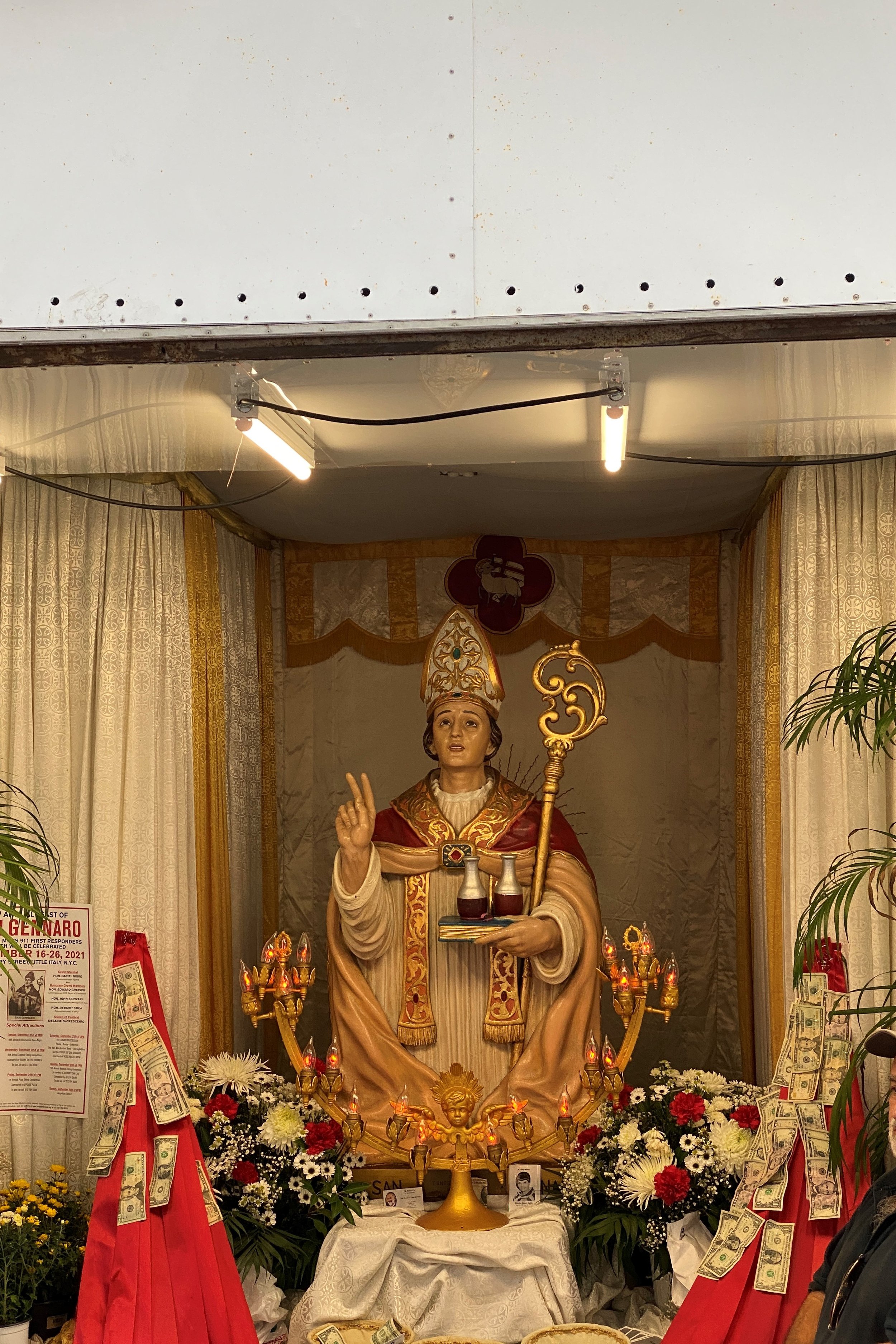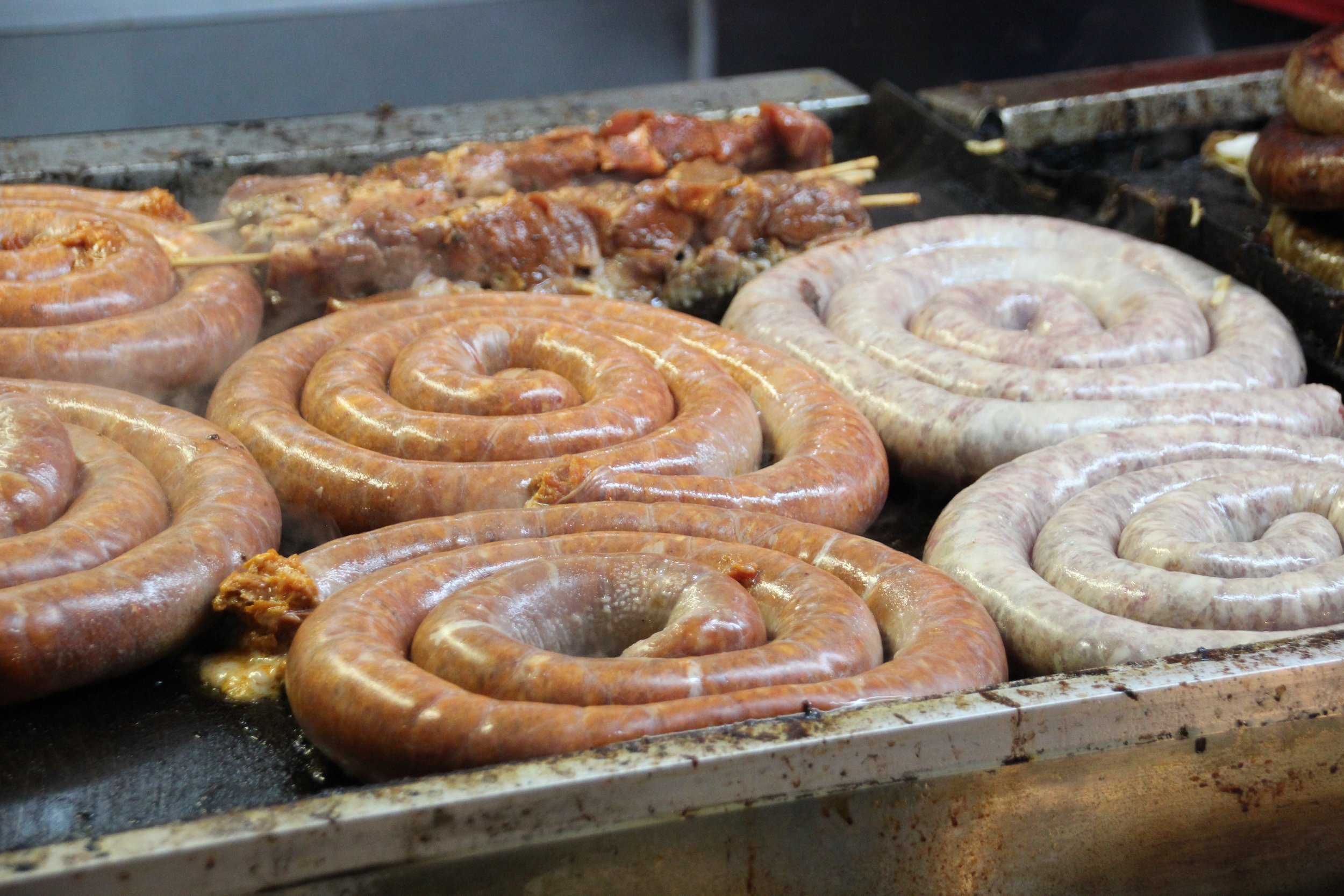San Gennaro: A Gastronomic Celebration of Immigrant Foods
Text and Photos by Ian MacAllen
Sweets generally are an important part of the festival. Torrone, a nougat filled with almonds or pistachios, is common.
On a warm, sunny September afternoon years ago, I was learning to shoot film on a vintage 35mm Minolta camera. I stumbled across New York City’s San Gennaro festival. The bright colors and motley foods provided a spectacular palette for experimenting. San Gennaro titillates a full spectrum of senses, but none more than taste, a triumph of gastronomic excess. It is the culmination of the abbondanza, the great abundance, a concept celebrated by Italians arriving in America to describe the bounty of food and wealth they found.
The great wave of Italian immigration began in the 1880s. Italy had unified only a decade prior, and cultural identity derived from regions, cities, and even neighborhoods remained an important legacy among immigrants. In cities like New York, enclaves formed within the larger ethnic communities. Congregating around Mulberry Street in the Lower East Side of Manhattan sprung up a neighborhood today known as Little Italy, with a large number of families from Naples and the surrounding suburbs.
The Feast of San Gennaro originated in Naples as a religious celebration. In New York, the festival burgeoned into a unique, ostentatious display of Italian American culture, that like red sauce cuisine—the spaghetti and meatballs, veal parmigiana—transformed an Old World tradition into a spectacle of food, drinking and vice.
The festival celebrates Saint Januarius, or Gennaro in Italian, the patron saint of Naples, where he is second only to the Virgin Mary. Southern Italians more generally revere Gennaro as the patron of agnostics, writes Nicholas Pileggi in a 1968 New York Magazine article titled “Little Italy: Study of an Italian ghetto.” Januarius I of Benevento became a priest at age 15, Marlena Spieler writes in A Taste of Naples: Neapolitan Culture, Cuisine, and Cooking, eventually working his way through the clergy to the rank of Bishop. He earned devotion from Naples when he led his people to safety following an eruption of Mount Vesuvius, an active volcano looming over the city. He was martyred in 305 CE, losing his head during the Great Persecution under Emperor Diocletian.
Naples commemorates the Festa di Gennaro beginning with a Catholic Mass. Afterward, a precession through the streets includes statues of Gennaro, and the faithful celebrate with candies and fried foods, Spieler writes.
***
The feast returned in 2021. Gennaro’s bust was back in his shrine, the sausages sizzled and the cannoli stacked high.
The first San Gennaro festival in New York looked more like this Neapolitan celebration than the current 11-day, multiblock carnival that descends on lower Manhattan each year. In 1926, a group of men led by Alexander Tisi roasted several chickens on the street to celebrate the patron saint of Naples, writes Ari L. Goldman in his 1982 New York Times story “The History of the Feast of San Gennaro.” Hosted on September 19, a Sunday that year, the first celebration consisted of neighbors, friends and relatives; it had a block party atmosphere. People paraded around Mulberry Street, imitating the rituals of their homeland, and the organizers awarded prizes for the best decorated fire escape.
Tisi quickly realized the festivities were attracting people from outside the neighborhood and formed the Societa San Gennaro Napoli e d’Intorni to organize and run the festival.
The Society earned money selling vender stalls to accompany the festival, and these helped create the street fair we see today. One of the earliest venders included the sausages of John Fasullo, who continued working his stand well into his nineties. Italian sausage sandwiches have since become synonymous with the festival. Cooked with onions and bell peppers and squeezed between crusty Italian bread, nearly every accounting of the festival from the 1940s through the present day mentions them. Calvin Trillin, writing “Confessions of a Standup Sausage Eater” for the New Yorker in 1981, described his hunt for the perfect sausage and pepper sandwich. Rushed by his daughters who believed all the thirty-odd stands were the same, he selected one he considered perfect, until turning around to find another stand selling sandwiches with sesame rolls.
The differences between sausage stands are subtle, but the common festival sausage consists of ground pork and fennel, and for hot Italian sausages, a healthy dose of chile peppers, per Craig Claiborne’s New York Times Food Encyclopedia. Another delicacy of the festival is the mulliatelle sausage, writes June Owen in the 1956 New York Times article “Feast of San Gennaro Provides Excuse to Visit.” This Neapolitan sausage is made from calves’ brains, hearts and lungs. Sausages adulterated with fat, additives and cheap cuts like offal offered the impoverished southern Italians economical access to meat.
Small pizzas have a long history with the festival as well, Owen writes in “Big Time in Little Italy: Feast of San Gennaro,” for the Times in 1955. Pizza was a natural fit since it originated in the working-class neighborhoods of Naples. By the 1920s, pizzerias like Lombardi’s and Totonno’s were serving up Americanized pies, larger than the originals since they baked pizza in bread ovens. Festival pies, on the other hand, are smaller in diameter, closer in size to those sold in Naples. Folded pizza, better known as calzone, also appeared at food stands. The typical festival calzone is filled with ham and ricotta cheese, writes Raymond A. Sokolov in the 1972 New York Times story “Fare Along Mulberry Varies from the Sublime.”
Fried foods are a staple of Neapolitan celebrations, and the feast is no exception. Zeppole are synonymous with Italian street fairs in America.
Sweets generally are an important part of the festival. Torrone, a nougat filled with almonds or pistachios, is common. When the festival was canceled in 2001 because of the terror attacks in lower Manhattan, one seller, Vinny Sabato was left with more than 200 pounds of the candy, according to Lydia Polgreen in the September 2002 New York Times story “Feast Hopes to Recover from its Famine.” Cannoli are piled high at street stands. Variations have included the Cannoli Kronie, a round croissant filled with cannoli cream imitating the Cronut, and the Walnoli, a walnut-shaped, cream-filled pastry. Gelati and lemon ice is sold from street stands and the Italian cafes along Mulberry Street.
In the post-war period, San Gennaro grew into a regional Italian cultural celebration with chartered buses bringing ethnic Italians from as far as Ohio and Maine. The attractions of the fair helped unite the disparate groups, and the spectacle grew. The shrine to hold Gennaro’s bust rose to a three-story chapel illuminated with neon. In 1959, John de Lucia’s enormous tunnel of provolone got a mention in Claiborne’s Times story “Street Festival Begins Wednesday; Gastronomic Delights Await Visitors .” He used it to draw customers to his Mulberry Street latteria, a cheese shop. De Lucia sold cheeses in the shape of the Vatican gong, birds, fish and fruit, and enormous wheels as large as 1,000 pounds, Claiborne wrote in a 1960 Times piece.
***
The differences between sausage stands are subtle, but the common festival sausage consists of ground pork and fennel, and for hot Italian sausages, a healthy dose of chile peppers.
The festival offered Italian Americans in the midcentury the opportunity to showcase a food culture still seen as foreign. Over time, it lengthened from one day to 11, and at its largest, included as many as 400 vendors. San Gennaro has grown into undeniably the largest Italian festival in the United States, and it became a model for other fairs held around New York City, as well as Italian American festivals across the country.
At the same time, food representing the city’s diverse ethnic groups has, more or less, always been a part of the festival. As it expanded, it spilled over Canal Street from Little Italy into Chinatown, Fred Ferretti writes in “And on Mulberry St. A Midway with a Neapolitan Flavor,” a 1976 New York Times story. The Chinese restaurants benefited from the overflow of visitors and often set up their own stands for games of chance, unlicensed by the Society, according to Ferretti. Various accounts of the foods catalog a great diversity in ethnic cuisines. Through the nine decades, observers have noted tacos, yakitori, gyros, Syrian pastries, falafel, pork buns, egg rolls and hot dogs.
The festival reflected the gastronomic diversity of the city, but that didn’t stop critics from complaining. By the 1990s, the Italian population of Little Italy was shrinking as third- and fourth-generation Italians moved to the suburbs. Half the residents of the neighborhood identified as Italian in 1950, but by 2000, less than 6 percent still did, according to Sam Roberts for the New York Times. Newer residents resented the crowds complained the festival no longer reflected the neighborhood. The city sought to curb the fair, as it had back in the 1920s.
The culmination of the city's growing distaste for the street fairs and the ambitions of a new mayor led to a showdown over the 1995 festival. Mayor Rudy Giuliani, who had built a career prosecuting organized crime, accused the festival of serving as a cash grab for the Genovese crime family, one of the “five families” of New York. Giuliani installed his own consigliere, John C. Sabetta, a former prosecutor, as a watchdog. The festival would have to pay Sabetta's hourly fee to monitor the festival, Dan Barry writes in 1995 New York Times article “San Gennaro’s Officials Outearn Charity.”
The following year, members of the Genovese family were indicted and the charges included misappropriation of festival funds from the 1993 and 1994 festivals. Not even the dollar bills pinned to the statue of the saint were sacred. A month before the 1996 festival, Giuliani canceled the city-issued permit. Within just a few weeks, a new group was formed, the Figli di San Gennaro. Many of the old participants were banned. To keep the lights on, literally, the festival organizers were forced to pay the city for installation of string lights between the utility poles. Gambling was banned. San Gennaro's shrine was banned. The Ferris wheel was not issued permits. Giuliani had single-handedly remade the festival.
The Figli di San Gennaro continues to oversee the event today. The organization has instituted new entertainment, such as contests for cannoli eating, pasta eating, meatball eating, zeppole eating and pizza eating, all mirroring the Coney Island Hot Dog Eating Contest sponsored by Nathan's Famous. The organization also helped see the festival through canceled feasts in 2001 and 2020.
The feast returned in 2021. For Washington Square News, the New York University student paper, Alex Tran laid out the usual argument against the festival, citing the piña coladas and tacos, comparing the food to the Olive Garden and decrying the condition of the Ferris wheel. But Gennaro’s bust was back in his shrine, the sausages sizzled and the cannoli stacked high.
Most years I pass through the festival for just a few blocks until the crowds feel overwhelming. I gawk at the frying sausage wheels and maybe buy a bag of zeppole. But 2021 felt different. The city had reopened. My son, born six months earlier sat strapped into a stroller. We cruised a few blocks with my in-laws, snacking on a fried pizza. That night we had reservations at C. Di Palo, just off Mulberry Street. The wine bar opened a few months before the city locked down, and by coincidence it was the last place I had eaten indoors. On that night, in the middle of the festival, the restaurant was full, customers were turned away for the lack of tables. Everyone was there to celebrate San Gennaro.



